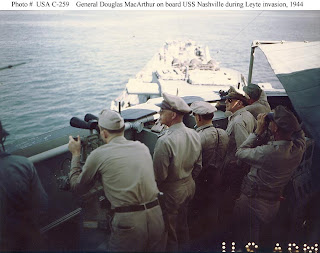
Another of the many ships Dad's ship
Vestal worked on in January 1943 was the USS
Nashville.
Vestal completed various "routine not alongside repairs" from today's date through the 21st.
Launched in 1937,
Nashville was a light cruiser, which by war's end had acquired quite a remarkable and distinguished history.
One of its first assignments was in September 1938. As war with Germany seemed inevitable, England secretly shipped onboard the Nashville $25,000,000 in British gold bullion for the United States. Then in the spring of the following year, the ship participated in a diplomatic mission, carrying American representatives to the Pan American Defense Conference Brazil. In June, she steamed for the Pacific via the Panama Canal to San Pedro, California for 2 years of operations. In February 1941, she and three other cruisers carried US Marines to Wake Island, and in May, she sailed from Pearl Harbor to Boston to escort a convoy carrying Marines to Iceland.
As the war approached for the U.S.,
Nashville was based at Bermuda as part of the Neutrality Patrol in the Central Atlantic. After the Japanese had bombed Pearl Harbor in December 1941,
Nashville joined a convoy to escort escort troops and cargo to Iceland. She continued escort duty to in the Atlantic until February 1942.
Later that spring, Nashville found herself in the carrier task force that delivered the Doolittle Raid on the mainland of Japan. In May, she was back defending Alaska and the Aleutians from Japanese invasion. Nashville continued to patrol the North Pacific and participated in the attack on the Japanese force on Kiska in the Aleutians in August, inflicting heavy damage on enemy shore installations. By November, Nashville was operating in the Pacific and escorted troop ships in the Guadalcanal Campaign.
In January 1943,
Nashville, along with
Helena and
Saint Louis, attacked the Japanese air base at Munda. It was during this period that the ship stopped for a week and a half for repairs from the
Vestal in Espiritu Santo. Then for the next several months
Nashville made several attacks during the fighting in the Solomons. While shelling the airfield on Kolombangara on May 12, she suffered an explosion in one of her gun turrets, killing 18 and injuring 17. After a stop at Espiritu Santo, the ship sailed for the West Coast for repairs and refitting.
Back in action in August 1943-1944, Nashville joined a carrier task force for attacks on Marcus and Wake Islands. In October, Nashville shelled targets on New Guinea and then supported Allied landings in the New Guinea Campaign of 1944.
In April of that year,
Nashville served as the combat flagship for General of the Army, Douglas MacArthur, in amphibious operations against the Japanese. As part of the assault force in May, she sustained damage while repelling a Japanese air attack, requiring repairs again at Espiritu Santo.
Nashville again carried MacArthur to the invasion of the Dutch East Indies in September. Then October 20, 1944, MacArthur departed the
Nashville for his famous "I have returned" walk onto the beach on Leyte.
In December of that year, while on operations in the Philippines, Nashville was hit by a kamikaze. 133 sailors were killed and 190 wounded. The damaged sustained required another trip to the West Coast for extensive repairs. She returned to the Philippines in May 1945, and took up her duties again as a flagship and in protecting the carrier force. She was operating in Indochina when the war ended.
With Allied victory over Japan achieved, in November 1945, Nashville sailed back and forth to the West Coast with returning servicemen. Decommissioned in June, she remained in reserve until 1950. She was sold to the Chilean navy in 1951, and served until 1985, when she was sold for scrap.
The USS
Nashville earned 10 Battle Stars for her WWII service.
Sources: USS Vestal War Diary, January 1943; Naval Historical Center
 While the biggest and most critical jobs in January 1943 at Espiritu Santo were repairing battle damage to the Pensacola, Minneapolis, Alchiba, and Achilles, Dad's ship, Vestal, still had numerous "routine not alongside repairs" to many other vessels. Maintaining the fighting and support vessels of the fleet was an ongoing, often round-the-clock work.
While the biggest and most critical jobs in January 1943 at Espiritu Santo were repairing battle damage to the Pensacola, Minneapolis, Alchiba, and Achilles, Dad's ship, Vestal, still had numerous "routine not alongside repairs" to many other vessels. Maintaining the fighting and support vessels of the fleet was an ongoing, often round-the-clock work.











